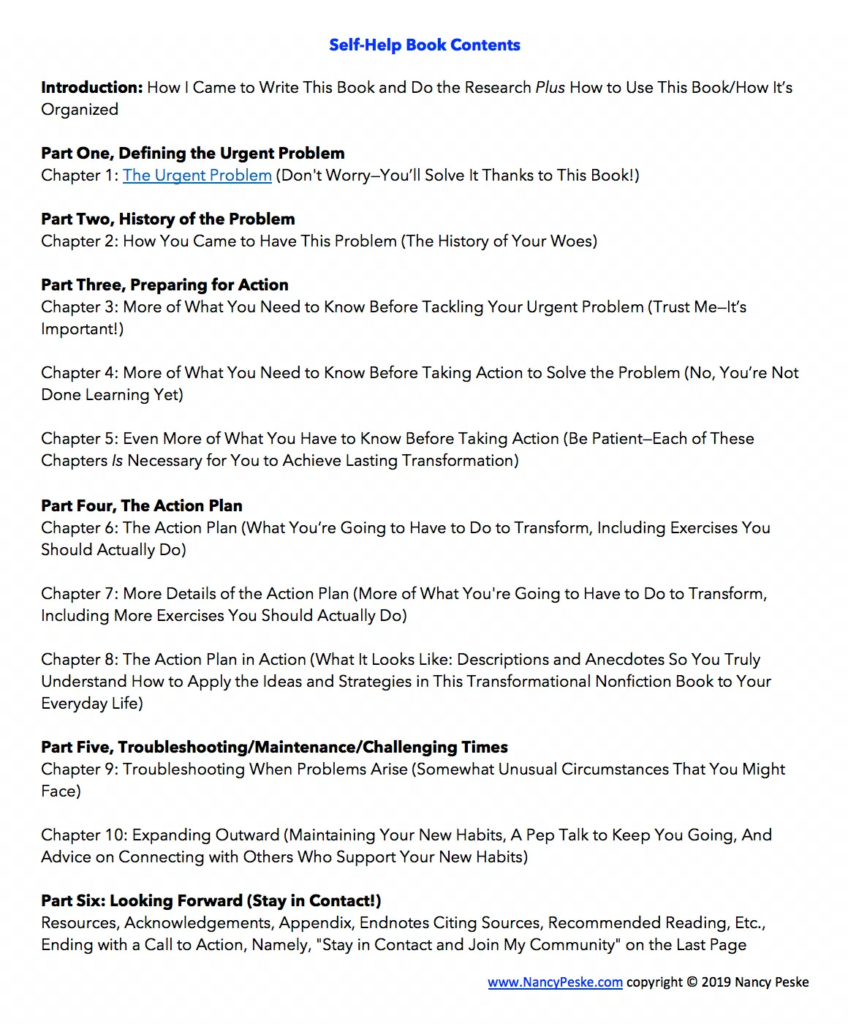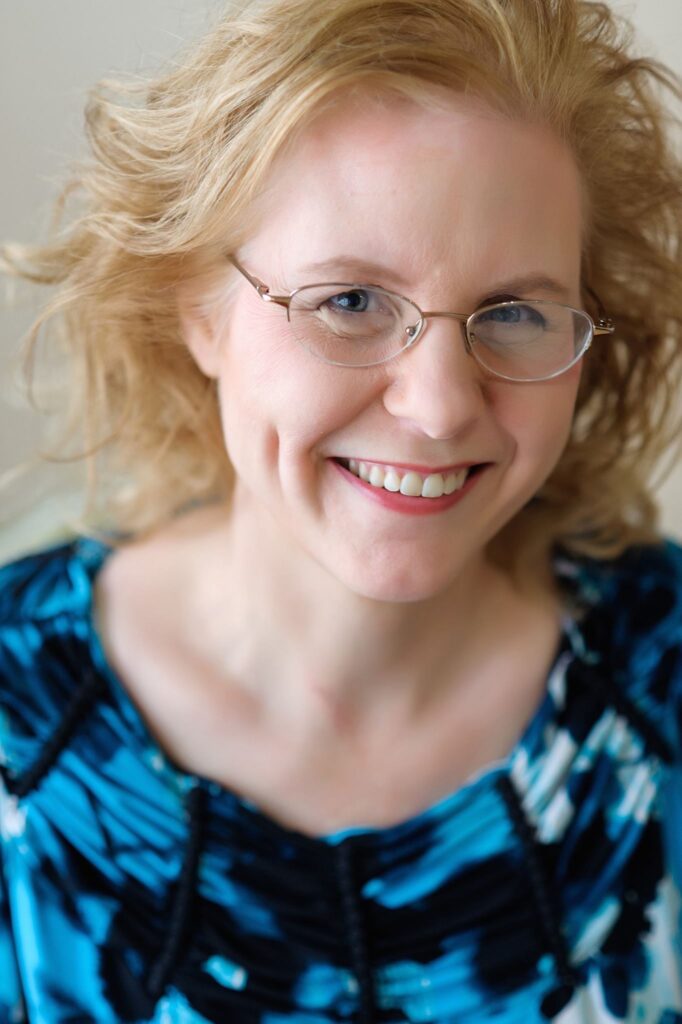SELF-HELP BOOK CONTENTS AND STRUCTURE: A HANDY GUIDE
In my YouTube video on structuring a self-help book, I described the parts of a self-help book. Each of these parts helps you, the author, to take the reader on a journey, keeping them engaged and oriented as they go through a process of transformation (which is why self-help books are often called transformational nonfiction books). When you divide those parts of the self-help book into chapters, you are likely to end up with more than one chapter per part.
That said, you might find that one of those parts, such as the action plan, just needs to be a section of a chapter. When that’s the case, you probably will have exercises throughout the book.
Self-help books should have exercises for the reader to use to start understanding and applying the book’s ideas and strategies. An action plan in a self-help book gives them an overall strategy for using the individual exercises as well as the strategies over a period of time to build new habits. I’ve worked on books that have an action plan at the end of the book that lays out how to employ the strategies and exercises the reader has learned (an example is Goddesses Never Age by Christiane Northrup). However, the typical place for the action plan is within the book itself after the reader has been set up to truly understand the ideas and strategies they’ll be employing.
Also, consider having a list of takeaway points at the end of each chapter so that the reader can refer back to the key ideas presented in each chapter.
Here’s a handy guide to the sections of a self-help book and how they can be broken into chapters:
Self-Help Book Contents
Introduction: How I Came to Write This Book and Do the Research Plus How to Use This Book/How It’s Organized
Part One, Defining the Urgent Problem
Chapter 1: The Urgent Problem (Don’t Worry—You’ll Solve It Thanks to This Book!)
Part Two, History of the Problem
Chapter 2: How You Came to Have This Problem (The History of Your Woes)
Part Three, Preparing for Action
Chapter 3: More of What You Need to Know Before Tackling Your Urgent Problem (Trust Me—It’s Important!)
Chapter 4: More of What You Need to Know Before Taking Action to Solve the Problem (No, You’re Not Done Learning Yet)
Chapter 5: Even More of What You Have to Know Before Taking Action (Be Patient—Each of These Chapters Is Necessary for You to Achieve Lasting Transformation)
Part Four, The Action Plan
Chapter 6: The Action Plan (What You’re Going to Have to Do To Transform, Including Exercises You Should Actually Do)
Chapter 7: More Details of the Action Plan (More of What You’re Going to Have to Do to Transform, Including More Exercises You Should Actually Do)
Chapter 8: The Action Plan in Action (What It Looks Like: Descriptions and Anecdotes So You Truly Understand How to Apply the Ideas and Strategies in This Transformational Nonfiction Book to Your Everyday Life)
Part Five, Troubleshooting/Maintenance/Challenging Times
Chapter 9: Troubleshooting When Problems Arise (Somewhat Unusual Circumstances That You Might Face)
Chapter 10: Expanding Outward (Maintaining Your New Habits, A Pep Talk to Keep You Going, And Advice on Connecting with Others Who Support Your New Habits)
Part Six: Looking Forward (Stay in Contact!)
Resources, Acknowledgements, Appendix, Endnotes Citing Sources, Recommended Reading, Etc., Ending with a Call to Action, Namely, “Stay in Contact and Join My Community” on the Last Page
Of course, you don’t have to have ten chapters. You might have six, twelve, or twenty-three. What’s most important is that the overall structure supports the reader’s journey, or what might be called a hero’s or heroine’s journey, that meets them where they are and takes them where they want to go. They start with identifying the problem (and being emotionally engaged by your book!) to feeling empowered to create new habits and sustain them. The idea is to experience personal transformation and even affect the world in a positive way, applying new strategies to interactions they have out in the community and even connecting with other like-minded individuals who are on a similar path. For example, recently, I worked on a self-help book that ended with advice on how to connect with other women in a sisterhood of support for sustaining the habits promoted in the book—how to communicate with them in ways that support and honor each other, how to heal old wounds around being betrayed by other women, and so on.
Readers of self-help books expect to read stories of others who took the journey and had struggles they can relate to. They also expect to receive practical guidance. Your self-help book’s exercises might include guided visualizations, journaling/workbook-type exercises, meditation/body scan exercises, and practical experiments such as trying out a new behavior every day (reciting affirmations, for example).
Now, that last piece about affecting the world in a positive way might sound lofty, but many people want to improve some aspect of their lives not just to alleviate discomfort or embarrassment, or make more money or have better relationships, but to expand on their joy by inspiring and encouraging others, attracting new clients and friends and partners, and improving how things work in our families, workplaces, and communities. Increasingly, I’m finding my clients are putting more consideration into what goes into this last part. Asking readers to join your community by signing up for your mailing list or a group you moderate on your site or on Facebook (such as a closed group) keeps people connected to your brand and participating in a larger conversation and movement. We’re all exquisitely aware of how much the world is changing and how strongly we want to affect it positively. I encourage those of you who are writing self-help to give some thought to what would be in the last part of your self-help book and how you will stay engaged on social media and through a mailing list, speaking events including workshops, and other outreach.

A handy guide to the six-part self-help book structure with chapters listed.
Was this blog piece and handy self-help book structure guide helpful? I hope so! If you do get stuck, contact me at nancy@nancypeske.com and give me details so we can set up a consultation.

Nancy Peske is a ghostwriter, developmental editor, and book publishing consultant who has done editorial work on books including bestsellers and award-winners for over 30 years.